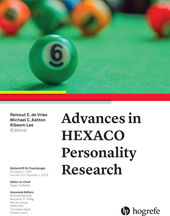Abstract
Abstract. Unobtrusive behavioral cues of personality traits can be found in physical and virtual environments (e.g., office environments and social media profiles), but detecting and coding such cues are a painstaking effort, and therefore impractical for research purposes. Measuring people’s choices in a virtual, gamified environment may offer a suitable substitute. It is currently unknown whether Honesty-Humility can also be assessed in a virtual environment. In two studies, we demonstrate that Honesty-Humility can be inferred with at least modest validity from virtual behavior cues. In a third study, we tested the fakeability of the virtual cues. This study found that even under faking instructions the virtual cues were related to Honesty-Humility, however, the virtual cues were just as fakeable as self-reported Honesty-Humility. Our results imply that virtual cues can be incorporated in serious games to measure personality. Future research may investigate whether the identified virtual cues are able to predict important Honesty-Humility related outcomes.
References
(2017). Comparing job applicants to non-applicants using an item-level bifactor model on the HEXACO personality inventory. European Journal of Personality, 31, 669–684. https://doi.org/10.1002/per.2120
(2014). The HEXACO honesty-humility, agreeableness, and emotionality factors: A review of research and theory. Personality and Social Psychology Review, 18, 139–152. https://doi.org/10.1177/1088868314523838
(2010). Avatars as information: Perception of consumers based on their avatars in virtual worlds. Psychology, & Marketing, 27, 741–765. https://doi.org/10.1002/mar.20354
(2006). A meta-analytic investigation of job applicant faking on personality measures. International Journal of Selection and Assessment, 14, 317–335. https://doi.org/10.1111/j.1468-2389.2006.00354.x
(2016). New talent signals: Shiny new objects or a brave new world? Industrial and Organizational Psychology, 9, 621–640. https://doi.org/10.1017/iop.2016.6
(2011). From game design elements to gamefulness defining “gamification”. Proceedings of the 15th International Academic MindTrek Conference: Envisioning future media environments (pp. 9–15). New York, NY: ACM Press. https://doi.org/10.1145/2181037.2181040
(2009). De zes belangrijkste persoonlijkheidsdimensies en de HEXACO persoonlijkheidsvragenlijst
[The six most important personality dimensions and the HEXACO Personality Inventory] . Gedrag, & Organisatie, 22, 232–274.(2016). Evolution, situational affordances, and the HEXACO model of personality. Evolution, & Human Behavior, 37, 407–421. https://doi.org/10.1016/j.evolhumbehav.2016.04.001
. (2009). The Sims 3. [PC Game]. Retrieved from http://www.thesims.com/
. (2014a). SimCity. [PC Game]. Retrieved from https://www.ea.com/nl-nl/games/simcity/simcity
. (2014b). The Sims 4. [PC Game]. Retrieved from http://www.thesims.com
(1987). An evaluation of the personality research form with Filipino university students. International Journal of Psychology, 22, 399–407. https://doi.org/10.1080/00207598708246781
(2015). What does my avatar say about me? Inferring personality from avatars. Personality and Social Psychology Bulletin, 41, 237–249. https://doi.org/10.1177/0146167214562761
(2005). The personal living space cue inventory: An analysis and evaluation. Environment and Behavior, 37, 683–705.
(2002). A room with a cue: Personality judgments based on offices and bedrooms. Journal of Personality and Social Psychology, 82, 379–398. https://doi.org/10.1037/0022-3514.82.3.379
(2011).
Manifestations of individual differences in physical and virtual environments . In T. Chamorro-PremuzicS. von StummA. FurnhamEds., The Wiley-Blackwell handbook of individual differences (pp. 773–800). Oxford, UK: Wiley-Blackwell. https://doi.org/10.1002/9781444343120.ch30(2000). A heuristic method for estimating the relative weight of predictor variables in multiple regression. Multivariate Behavioral Research, 35, 1–19. https://doi.org/10.1207/S15327906MBR3501_1
(2005). Psychopathy, machiavellianism, and narcissism in the five-factor model and the HEXACO model of personality structure. Personality and Individual Differences, 38, 1571–1582. https://doi.org/10.1016/j.paid.2004.09.016
(2018). Psychometric properties of the HEXACO-100. Assessment, 25, 543–556. https://doi.org/10.1177/1073191116659134
(2016). Signature size signals social dominance and narcissism. Journal of Research in Personality, 65, 43–51. https://doi.org/10.1016/j.jrp.2016.09.004
(2003). Warning against faking on personality tests: Effects on applicant reactions and personality test scores. International Journal of Selection and Assessment, 11, 265–276. https://doi.org/10.1111/j.0965-075X.2003.00250.x
(1992). Comparing correlated correlation coefficients. Psychological Bulletin, 111, 172–175. https://doi.org/10.1037/0033-2909.111.1.172
(2009). Personality judgments based on physical appearance. Personality and Social Psychology Bulletin, 35, 1661–1671. https://doi.org/10.1177/0146167209346309
(2019). Self-presentational motives and public self-consciousness: Why do people dress a certain way? Journal of Personality, 87, 648–660. https://doi.org/10.1111/jopy.12423
(2013). The impact of “non-targeted traits” on personality test faking, hiring, and workplace deviance. Personality and Individual Differences, 55, 162–168. https://doi.org/10.1016/j.paid.2013.02.027
(2011). Our Twitter profiles, our selves: Predicting personality with Twitter. IEEE conference on Privacy, Security, Risk and Trust (PASSAT) and 2011 IEEE Third International Conference on Social Computing (SocialCom). New York, NY: IEEE, 180–185. https://doi.org/10.1109/PASSAT/SocialCom.2011.26
. (2013). Grand Theft Auto V [PC Game]. Retrieved from http://www.rockstargames.com/
(2011). How do you fake a personality test? An investigation of cognitive models of impression-managed responding. Organizational Behavior and Human Decision Processes, 116, 163–171. https://doi.org/10.1016/j.obhdp.2011.05.003
(2010). Conceptual framework for modeling, assessing and supporting competencies within game environments. Technology, Instruction, Cognition and Learning, 8, 137–161.
(2013). Validation of data-driven computational models of social perception of faces. Emotion, 13, 724–738. https://doi.org/10.1037/a0032335
(2011). Modeling social perception of faces. IEEE Signaling Processing Magazine, 28, 117–122. https://doi.org/10.1109/MSP.2010.940006
(2008). Portrait of a narcissist: Manifestations of narcissism in physical appearance. Journal of Research in Personality, 42, 1439–1447. https://doi.org/10.1016/j.jrp.2008.06.007
(2010). The mapping principle, and a research framework for virtual worlds. Communication Theory, 20, 451–470. https://doi.org/10.1111/j.1468-2885.2010.01371.x
(2013). A virtual “room” with a cue: Detecting personality through spatial customization in a city simulation game. Computers in Human Behavior, 29, 155–159. https://doi.org/10.1016/j.chb.2012.07.029
(2014). Personality and behavior in a massively multiplayer online role-playing game. Computers in Human Behavior, 38, 322–330. https://doi.org/10.1016/j.chb.2014.06.009
(2015). Dimensions of video game behavior and their relationships with personality. Computers in Human Behavior, 50, 132–140. https://doi.org/10.1016/j.chb.2015.03.056
(2010). Honesty-Humility and a person-situation interaction at work. European Journal of Personality, 24, 569–582. https://doi.org/10.1002/per.757



